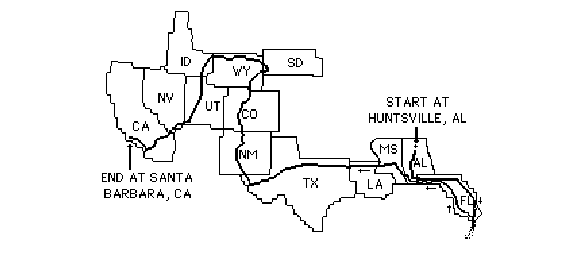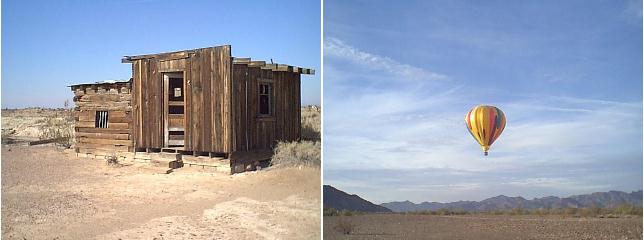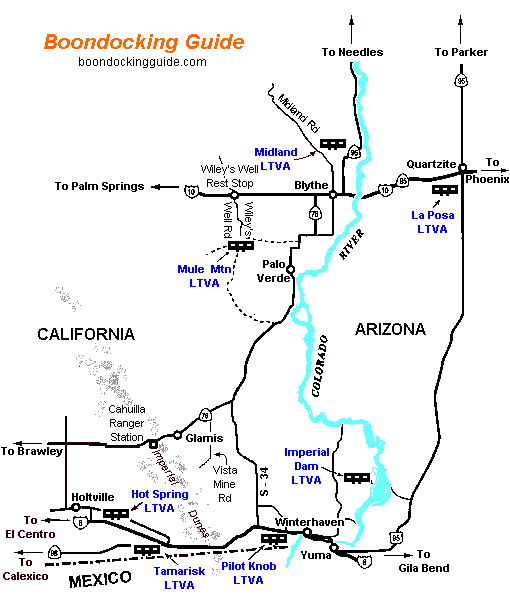Chapter 2 - Parking and Dumping Free
In our five months on the road, we learned alot about where to park for free, where to look for the essentials (like water to fill up your tanks and dump stations to dump your other tanks) and a few general rules on how to get along in the travel world. One of the things we learned was that the old story about getting a self-contained motorhome and parking anywhere you want to is attractive, but not entirely true. It also turns out that some of the simple things like dumping your tanks can get expensive if you don't know what to look for and where to look. The second chapter contains some hints on these and other related topics.
To start things off, the map below shows our five-month route. Note that although we passed through 13 states, we really only 'covered' a significant portion of six of them. It was in these six states that we developed some of our stronger opinions about finding free places to park, dump, eat, relax, tan, fish, explore, and enjoy. This rather crude drawing, as well as many of the others in this book, are from the original 1990 version of the book, created on a MacPlus using MacDraw. Decided to keep them as is instead of replacing them with spiffy, modern drawings.
You're Visitor #
Retire and Travel For $1000 a Month


Before I go any farther, let me explain a little about why I keep mentioning dumping the tanks -- if you haven't spent much time in a motorhome, you probably have no idea why it's of any importance. In a motorhome, you've got two tanks -- the grey water and the black water. The grey tank is where your sink and tub water goes and the black tank is where your toilet water goes. You have gauges inside the motorhome that tell you when the tanks start getting full. If your grey tank gets full, you can probably sneak out at night and empty it almost anywhere without getting anyone too upset with you. When the other one gets near full, however, you've got to find a designated dumping spot to put it. This means finding a place that has a dump station, connecting your dump hose, and emptying the tanks. This happened to us about every 3-5 days -- I suppose it probably depends on how much you eat. Also, we seldom used any bathroom other than the one in the motorhome.
Anyway, the first time the black tank got nearly full, we started looking for a dump station and found one at a campground -- only problem was that it cost $2 to use it. A few miles down the road, we saw a free one at a rest area. That is the last time we paid to dump. As it turns out, there are alot of free places if you keep your eyes open and don't panic. If we had continued paying, even at only $2 a pop, it would have cost us about $60-$100 -- definitely not planned in our budget. Some places to watch for -- most motorhome dealers will let you dump free in hopes that you will buy something from them; the rest areas in most states will have a 'dump' symbol on their sign -- these are always free (Florida has many, on both the Sunshine State Parkway and on the lesser highways; Texas has many; New Mexico has them at almost all of its rest areas; etc.). As a matter of fact, the states like those just mentioned that have alot of motorhome travelers seem to go to great lengths to have them available -- we had little trouble finding any after we got west of Louisiana. The only states where they are a problem are those that are not as popular with motorhomers, like Alabama and Mississippi, although these were good too when you got near the coast where the tourists hang out. I would guess that the North-Eastern states, especially around big cities, would be rather sparse also -- but this is only a guess. At any rate, you should always be able to find a smiling motorhome dealer who wants to stay on your good side. The bottom line is don't panic and pay -- you can dump it free somewhere. The only time I found it necessary to use an 'undesignated' spot was when we camped in the Florida Keys (under a bridge) for a month -- then I put it in the ocean once or twice and watched it (guiltily) go out with the tide. I had heard that people in boats do it all the time, but I still felt guilty adding my refuse to the ocean with 10,000 other people. One of the unwritten rules of most full-timers seems to be to try to keep the country clean -- even though I was only one of many-many, I wouldn't have done it if there had been an alternative.
Well, enough about dump stations -- how about some discussion of free parking? This is where you really have a chance to get innovative, especially in Florida and California. Most other states don't have as many motorhomers coming through and are therefore not as strict on overnight camping, but these may be the very states that you are most interested in so here are some ideas. These free parking hints are intended for people who don't want to spend the $8-$20 and up fees for parking in campgrounds (unless you can park for $1 a night -- see Chapter 5 on camping clubs). Update! You can camp most anywhere in the country at $6-7 per night if you simply join Passport America and camp for half-price at hundreds of campgrounds.
Rule one on finding a parking spot is Park Before Dark. Whether you're in the city or the country, it's best to find a nice spot before dark sets in. There are a number of reasons for this rule. Firstly, it's not fun. There are few things less enjoyable than wandering around in unfamiliar territory trying to find a place to stop. You're trying to go slowly enough to pick a spot, but not so slowly that you hold up traffic and become the target of angry horn-blowers. You're tired and want to stop as soon as possible, but you want to be sure you have a decent spot where you won't be run off as soon as you get settled.
Secondly, it's dangerous. Because you're in unfamiliar territory and other drivers are intolerant and you're tired and it's dark, you find yourself trying to stop in places that you wouldn't consider if conditions were different. In the city, you might find out too late that the drive you just turned into is steeper than you expected and the back end is about the scrape long and loud ... or there's not a level spot anywhere in the parking lot ... or it's in a real unfriendly-looking neighborhood -- which you won't notice until tomorrow morning. In the country, the main danger is turning in at a place where the ground is much softer than it looked from the road. We never got stuck, but came real close a few times. I can't imagine what we would have done if we had gotten stuck in some of those places ... you intentionally look for a secluded spot so you can camp without being bothered, but if you were to get stuck you might find that this seclusion serves to keep you from getting any help for a long time. The other danger is that you can't see where you really are until in the morning, then it's too late to worry about it. We waited too late a few times and ended up in some very undesirable parking spots. Once we woke up to the sound of a herd of cattle bumping on the side of the motorhome -- seems we had stopped right in the middle of their main trail from the barn to the pasture.
Well, that's probably enough about rule one, now what about finding free camping spots? Your best bet for free parking is Shopping Malls with big parking lots -- they are generally well-lit (so with your curtains closed, noone can tell if you're inside or not), they are usually well-patrolled by police so you probably won't get bothered, they give you some entertainment (watching people) if you are bored, and you can more easily find a level spot. Of our approximately 150 days on the road, we probably spent about 25 in the front yard of friends or relatives, about 80 in neat out-doorsie areas, and the remainder in cities. If you're in a city, look for a shopping mall (probably 90% of our city parking was at malls). If there are 'No Camping' signs in the parking lots, believe them -- many a night we got 'run off' by police at midnight and found ourselves searching (bleary-eyed) for a place to hide. If the parking lots are marked (as they are in South Florida, the Florida Keys, and most of California), then you have a chance to get super-innovative. Even the roadside rest areas in these places are marked -- they really want you to use their campgrounds. Of course, we all know of the recent decision by Wal-Mart to allow RVs to stay in any of their parking lots overnight. I've found this to be a real boon, since there's usually one around when you need it ... lol.
Probably your next best bet after Mall parking lots is large motel lots. Believe it or not, some people travel in a motorhome and still stay in motels (we did once in Glenwood Springs, Colorado because we were ready for a celebration and Joyce really wanted a hot bath -- besides, it was snowing outside ... in July). Anyway, assuming that you have good, solid curtains for your home (which you really need whether you camp sneakily or in campgrounds), you can park in a motel lot and no one even knows or cares if you're inside the motorhome or the motel. If you're real tired and you can't find a motel, another fairly safe bet is the parking lot of a large apartment complex. If anyone questions you, just tell them you are friends of the Smith's in apartment #9 -- most apartment houses have a #9 and a Smith -- any number less than 9 may put you too close to the manager's apartment -- any number bigger may be too large. If you want to be really safe, go look at the mailboxes and pick out a name and number.
Other innovative places we stayed: We found that bank parking lots are good on weekends because they often get a Saturday and Sunday newpaper which nobody needs until Monday anyway. Roadside rest areas in Texas are good -- most have a dump station and some even have water. Rest areas in New Mexico are fantastic! In most, you can stay up to 30 days and they provide you with water and sometimes even electricity. Federal parks are bad for finding free parking places -- they have campgrounds and want you to use them (even if they're full, which they often are). One of the few times that we were forced to pay was in Yellowstone Park -- there was really no place to stop without leaving the park.
Our most innovative stay was in the Florida Keys and was discovered totally by accident. When we first got into the Keys (Upper Matecumbe Key), we spotted what looked like a roadside parking area with about 8 campers in it and settled in. At about 11:30 that night, here comes the sheriff and tells everyone to go to a campground. Here we are, wandering down the highway in the rain, determined not to spend money on a campground. We noticed what looked like a parking lot under one of the bridges and, with great care, traversed a little trail about 10 feet wide to get to it. We camped there overnight and thought we had really discovered something. On the second night at about 9 P.M., I happened to be outside fishing when here comes the sheriff. We chit-chatted for awhile and he told me that if we are there fishing we could stay as long as we like, but not to do any camping (Who, me camp?). I later noticed about 50 or so fisherman/campers at the other end of the bridge fishing and shrimping. We stayed there about a month, being very careful to leave our poles and shrimp net outside the door under the (lit) porch-light and were never again questioned. During that time, we were periodically joined by other "fishermen", who would generally stay 2-3 days and did about as much fishing as we did. We met alot of people, I learned a little about oil-painting (learned that Joyce is a painter and I am not), and had several interesting adventures.
To diverge for a moment, three of the adventures that we had in the keys are worth telling. One morning some scuba divers came by and started swimming around our parking lot. They were obviously marine biologists and found some of the strangest things I have ever seen come out of the water -- like sponges that looked like rocks and fish that I previously had only seen in aquariums. At one point, I and a guy from New York were standing on a rock watching his friends diving and we spotted a pistol in the water. I assumed it was a toy, so didn't go in after it. He did -- and found out that it was a Mauser 6.35 with 7 bullets in the clip. After a little work, he managed to cock the hammer so we concluded that it must not have been in the water very long -- very curious. What kind of a story could you concoct about a pistol thrown off of a bridge in the Florida Keys at midnight (it must have been midnight, it always is in the movies). At any rate, he took the gun and left so I never did find out if he checked further to try to find out about it or not. That's my first story with a let-down at the end.
The second adventure relates to the old note-in-the-bottle trick. When we got ready to leave our parking lot, we put a note in a bottle with our name and address and the date. Now it's six years later and we haven't heard anything about the bottle since. ha! ha! Second story with a let-down.
The third adventure is about a bikini. One morning I was outside fishing and Joyce was painting, when along came a couple in a car (obviously not campers or fishermen). We watched them half-heartedly and found that he was a photographer and she was a model. It was a hot day and the wind was blowing nicely and he was snapping her picture in all kinds of positions (up the side of the bridge, on the rocks, wading in the water, etc). It was fairly interesting with her in a bikini and the fish not biting anyway. It got somewhat more interesting when she took off her bikini top and he continued taking a series of shots in various attractive positions. Since I thought this might be worthwhile for our pictorial records, I took some pictures also. This story thus ends on a high note, except for the fact that I can't seem to find any of these pictures in our photo albums -- I can't really remember if I just thought about taking pictures, if the photo shop neglected to develop them, or if they disappeared afterwards -- Joyce says she doesn't remember either... hmmm.
Well, to sum it all up, we had a glorious time in the Keys. We got very tanned, Joyce finished some nice paintings, I caught a few inedible fish (and 13 very tasty shrimp), and we saved about $450 in campground fees. If you get down in that area sometime, I hope you are able to find a similar spot -- and I hope the sheriff doesn't read this book. Keep on fishing! Update: the sheriff must have read it -- went back to the 79.5 mile-marker a few years ago and found that they've fenced off our neat under-the-bridge camping/fishing area and are using it for storage -- what a waste of a beautiful camping area!
Here's a little add-on about the ultimate boondocking experience that I learned about in 1999. If you live in the Southwest, you no doubt are very familiar with Bureau of Land Management (BLM) lands. If not, read on and learn!
The BLM land has many areas where parking is free and others (with some amenities) that charge $125 for 7 months of winter camping in locations named Long-Term Visitor Areas (LTVAs). During the summer, it's mostly free. To read my experiences in using free areas and LTVAs, go read chapters 1-14 of My Travel Log. I've included an LTVA map with reference to an associated website below -- click the picture to go to boondockingguide.com.
My First Book
Nothing in this site is copyrighted -- I'd be honored if you'd reuse anything you find here for your website
 | ||||||
If you like boondocking, you really need to checkout the LTVAs. If you like flea markets, RV shows, ghost towns, desert scenery, hot-air balloons, camel races, and cacti, then you owe it to yourself to visit Quartzsite, Arizona in late December and early January. When I was there, traffic wasn't too bad until around mid-January -- then it got so crowded that I left. Below are a couple of pictures from Quartzsite -- many more available in My Travel Log.


